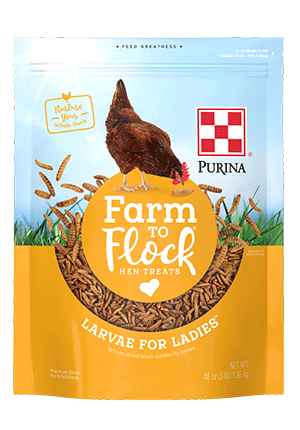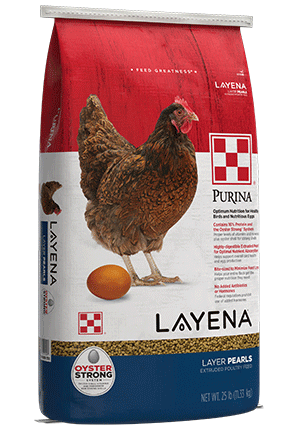
So Long, Summer! Prepare Backyard Animals for Winter Feed Changes
Starting a Flock : Caring for Chicks
Hobby Farm : Hobby Farming
Getting your hobby farm animals ready for cold weather can be a daunting task – everything from shoring up their shelter, keeping water sources from freezing, changing their routine and more. But one thing you might not be considering is switching your livestock’s feed for winter.
Let’s talk about why you should adjust your feeding routine in winter and some things to look for when choosing the right winter feed for your chickens and other animals.
This is even more important if an animal is pregnant during winter – they aren’t only trying to keep themselves warm, but they also need extra calories to support their growing baby.
Seems backward, right? In this example, the protein level is lower in cold weather because the animal is eating more total feed. On the other hand, ducks and turkeys don’t lay eggs in the winter months, so they don’t need to eat more. Birds have a higher body temperature and can easily adapt to colder weather.
Here are some things to think about when feeding your animals in cold weather:Best practices for switching feed
When switching feed for your chickens, horses or any other farm animal, make sure to think about everything that goes into it. Number one, do it slowly. Don’t shock your animals’ system with a different feed, or even a different amount of feed, overnight. Sudden changes can upset their stomach. Gradually replace the old feed with the new, increasing the amount of the new feed and decreasing the amount of the old feed over 7-10 days.
The biggest thing to remember is livestock are made to live outside. They’re built to change with the seasons. If you’re freezing outside, that doesn’t necessarily mean they are. If temperatures gradually decrease, livestock can adjust and prepare themselves for the colder weather. But when there are sudden drops in temperature or extreme weather, you need to be prepared to offer added support.
Do your research, know what your animal may need and be prepared when the temperature drops. They’re made to live outside, but that doesn’t mean you can’t help ‘em out a bit.
Want more tips? Sign up for our e-tips!
Let’s talk about why you should adjust your feeding routine in winter and some things to look for when choosing the right winter feed for your chickens and other animals.
Why change livestock feed in the winter?
As the weather changes, so does an animal’s energy needs. It’s the same for us – we burn more calories trying to stay warm than we do trying to stay cool. And, we usually eat less in the summer because it makes us hot. Our animals are the same way. By eating more feed and increasing their calories, your animals can keep themselves warm. Remember, an animal that’s eating is a warm animal.This is even more important if an animal is pregnant during winter – they aren’t only trying to keep themselves warm, but they also need extra calories to support their growing baby.
How to choose the right winter feed
The biggest factor in choosing a winter livestock feed is making sure you’re providing the right amount of nutrients for each animal’s specific needs. Do your research to know how much feed to provide and if you need to look for a feed with different levels of ingredients compared to your summer feed. For example, game birds need 16-20% protein in the warmer months but only need about 14% protein during the colder weather.Seems backward, right? In this example, the protein level is lower in cold weather because the animal is eating more total feed. On the other hand, ducks and turkeys don’t lay eggs in the winter months, so they don’t need to eat more. Birds have a higher body temperature and can easily adapt to colder weather.
Here are some things to think about when feeding your animals in cold weather:
- Don’t forget about hay! Make sure to have enough hay before winter starts. Grazing animals like beef cattle or goats will need extra hay when grass isn’t available.
- While most animals need more feed in winter compared to summer, watch out for overfeeding. Too much feed can be unhealthy for your animals.
- Consider housing – if animals live in a climate-controlled coop or barn, they may not need extra feed in winter.
- Water is just as important in winter as in summer. Keep water sources clean and make sure they don’t freeze.
Best practices for switching feed
When switching feed for your chickens, horses or any other farm animal, make sure to think about everything that goes into it. Number one, do it slowly. Don’t shock your animals’ system with a different feed, or even a different amount of feed, overnight. Sudden changes can upset their stomach. Gradually replace the old feed with the new, increasing the amount of the new feed and decreasing the amount of the old feed over 7-10 days.
Animals handle cold weather differently
Every animal has different methods to stay warm – some huddle together to share body heat, some grow more hair and some have thick enough feathers that they don’t even notice the chill.The biggest thing to remember is livestock are made to live outside. They’re built to change with the seasons. If you’re freezing outside, that doesn’t necessarily mean they are. If temperatures gradually decrease, livestock can adjust and prepare themselves for the colder weather. But when there are sudden drops in temperature or extreme weather, you need to be prepared to offer added support.
Do your research, know what your animal may need and be prepared when the temperature drops. They’re made to live outside, but that doesn’t mean you can’t help ‘em out a bit.
Want more tips? Sign up for our e-tips!





